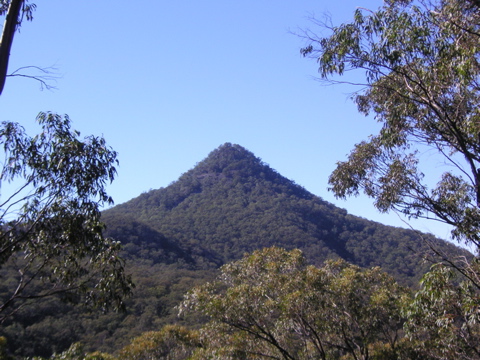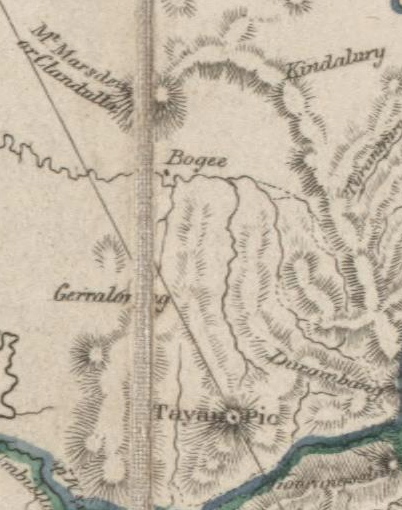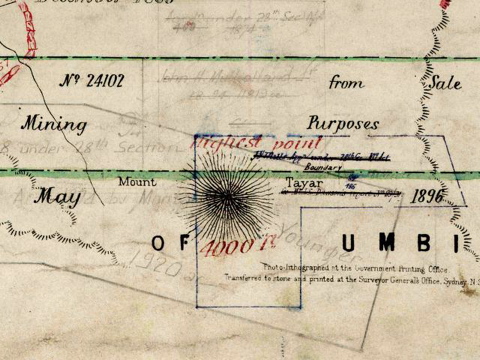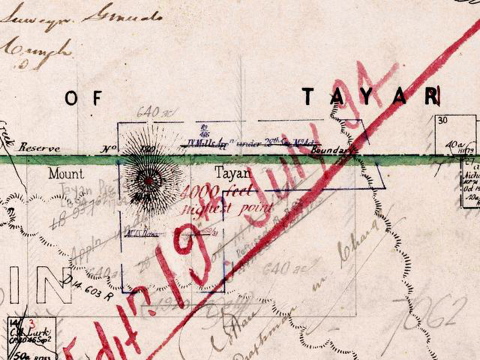Australian Indigenous place names often suffer distortion in form and meaning when they are adopted into English. The distortion can have many different causes: English speakers might not be able to hear the sounds of the source language properly or they might not understand what place the name really refers to. In the case of Tayan Pic (32º58’4″S, 150º12’58″E – picture shown below), a mountain near Kandos in New South Wales, however, the name has suffered further distortion after its adoption into English because of a misreading of the English transcription of the name. We first have to investigate the evolution of the name in English before we can begin to look into its Australian origin.

Tayan Pic
Tayan Pic was first officially recorded by the government surveyor Peter Ogilvie in 1829. He spelt the name of the mountain ‘Tiyan’ (Andrews 1992:133). Back in the Lands Department in Sydney the name of the mountain was variously spelt ‘Taian’ and ‘Tayan’ (Andrews 1992:132).
The mountain found its way on to Major (later Sir) Thomas Mitchell’s 1834 Map of the Colony of New South Wales with the name ‘Tayan Pic’. The ‘pic’ part is an obscure geographical term of Romance origin that refers to conical-shaped mountains. The term is listed in the full Oxford English Dictionary (if you have a Sydney University library card, you can access the electronic version of the entry). A grab from Mitchell’s map showing Tayan Pic is shown below.

Tayan Pic on Mitchell’s map (north is to the right)
The n on the end of Tayan is not at all clear to see on this map; it looks almost like an r. This misreading is almost certainly what led to later surveyors naming the creek that flows down the mountain ‘Tayar Creek’ (now Tayar Gully) and to naming the parish immediately to the north of the mountain ‘Tayar Parish’.1 This sort of corruption of a name through misreading has occurred elsewhere in the history of Australian toponymy. Nash (2003:37) provides several examples.
There was clearly confusion in the Lands Office over the proper name of Tayan Pic in the late nineteenth century. Below is a map of Tayar Parish from 1884 from the New South Wales Parish Map Preservation Project. On this map Tayan is ‘Tayar’.

Tayar Parish map 1884
On the 1884 map for Umbiella Parish (the parish to the south of Tayar Parish), however, the name of the mountain is given as ‘Tayan’. This can be seen in the picture below. Note that someone has tried to change the name of Tayar Parish on this map to ‘Tayan’.

Umbiella Parish map 1884
Today the Geographical Names Board of New South Wales lists the official designation ‘Tayan Pic’ for the mountain, but the parish and the creek remain ‘Tayar’.
Even though we can track down the earliest forms of the name in English, the question still remains where the name originally came from. There seem to be no records surviving from the time the area was first surveyed that answer this question. However, we can assume that the name most probably comes from an Australian language spoken in the area. The name seems to satisfy the phonotactic constraints of languages in the area. We also know that Mitchell, who was the Surveyor General at the time, had a preference for Australian names. Mitchell declared his preference for Australian names in many places, including in a letter to Ogilvie. He said that he would not ‘…suffer any Surveyor to give any river or place any other than the proper native names’ (letter from Mitchell to Ogilvie, 11/1/1830, quoted in Andrews 1992:132).
The first task in tracking down the origin of the name is to identify the source language. Tayan Pic lies on the border of several different languages. The language that was most likely spoken in the area around Tayan when Europeans arrived is Wiradjuri, but Darkinjung and Gamilaraay were also spoken nearby.
Unfortunately, we cannot be sure that the name the European surveyors attached to the mountain was in fact a place name in the source language. The Europeans might have asked a question like ‘What’s that place over there?’ and been told that it was a mountain, a place for collecting stones, or any number of things. We presently have no clues that would tell us what the word that became the English place name might have meant in the source language. We therefore have to rely solely on the form of the name in tracking down a likely source. This means that our proposals will be highly speculative. One piece of speculation that I would like to put forward is that the name derives from the Wiradjuri word dhirrayn or jirrayn (the ‘yn’ indicates a palatal nasal), meaning mountain or hill (McNicol and Hosking 1994:88).
There are other mountains in the area with similar names, which may all be renderings of the same source word. The variations in spelling among these names can provide clues about the likely form of the source word. Andrews (1992:138) reports that the mountain now known as Mt Coriaday (32º45′ S, 150º24′ E) was first recorded as ‘Towen’ by the surveyor Heneage Finch. And Merinda Turton has pointed out that there are two mountains to the north of Tayan Pic that have similar-sounding names: Mt Touwouwan (32º48′ S, 150º11′ E) and Mt Towinhingy (32º51′ S, 150º11′ E). Among these names we can see what might be a common element: tayan/towen/touwouwan/towin-. It might also help to find out if the ‘-hingy’ on the end of Towinhingy is a suffix in any local language and if so what it means or what word classes it can attach to.
David Nash, citing McNicol and Hosking (1993:56), has suggested that these names, or at least some of them, might derive from the Wiradjuri word dhawiyn ‘axe, stone axe, tomahawk’. McNicol and Hosking provide the source spellings ‘dawin, towin, dthou’in(y), dhauain, dhuuwiyn’ for this word. Nash points out that these mountains are all made from volcanic rock, which could be used to make axe heads. The mountains might therefore be named for their function as the source of materials for making axes. There are other cases in Australia of places being named in this manner.
The form of the name of Tayan Pic has been fairly unstable after its adoption into English. Fortunately, we have been able to find the earliest forms recorded in English and see how they have evolved. The life of the place name before it entered English (if it was a place name before it entered English) remains a mystery, however. Hopefully further investigation through records and further philological work will reveal more information about the origin of the name.
Notes
1All land in New South Wales is divided up into parishes and counties for land administration purposes. A civil parish bears no relation to a church parish.
Printed References
Andrews, Alan E.J. 1992. Major Mitchell’s Map 1834, the Saga of the Survey of the Nineteen Counties. Hobart: Blubber Head Press.
McNicol, Sally and Dianne Hosking. 1993. Wiradjuri. Canberra: the authors.
McNicol, Sally and Dianne Hosking. 1994. Wiradjuri. Macquarie Aboriginal Words, ed. by Nick Thieberger and William McGregor, 79-99. Macquarie University: Macquarie Library.
Nash, David. 2003. Authenticity in toponymy. Maintaining the links: Language, identity and the land (Proceedings of the Seventh FEL Conference, Broome, Western Australia, 22-24 September), ed. by J. Blythe and R. McKenna Brown, 36-40. Bath, UK: Foundation for Endangered Languages. (http://www.ogmios.org/proceed2003.htm)
 Follow
Follow
Great post, James!
As a person who visits the Bogee valley, I have found this an interesting article on one of the mountains we climb every year or so.
It gives some connection to the past, and a historic perspective to the local area.
John Giacon has suggested that one or more of the forms tayan/towen/touwouwan/towin- could be related to the Gamilaraay word thawun ‘earth, ground, dirt’.
He added the followings thoughts in a recent e-mail (which he gave me permission to post).
I’d prefer to see it as ancient evidence that there were speakers of Hittite in the area. The Hittite for ‘earth’ is tegan or something similar – a little lenition and Bob’s your uncle!
Seriously, though, very nice post!
I presume early colonial exploration of the Tayan area was from the south and south-west (is this supported in what you have read James?). Note that two parishes adjacent to the south and south-west are named Gindantherie (could the root be gindaayn ‘ring-tail possum’ (McNicol and Hosking 1993)?), and Morundurey. Both these names, assigned in the 19th century, look like they include the Wiradjuri comitative suffix which has the distinctive form -djuri ~ -dhuri. Hence I incline to a Wiradjuri origin for toponyms in the area of Tayan too (rather than the neighbouring languages).
I’ve just noticed more support for the proposed derivation from the Wiradjuri dhawiyn ‘axe, stone axe’: this root occurs in the placename Douwingerie glossed as ‘rocks from which stone tomahawks were made’ (Wellington district), Science of Man 7.6(1904),89. What is likely the same place was recorded as Dawindurai ‘present sheep station’ by the Rev. Günther (1840 MS, p.341=97).